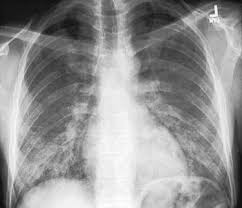
 Pneumocystis jiroveci causes an acute or subacute, potentially
life-threatening pneumonia in immunocompromised individuals, typically those with AIDS.
Pneumocystis jiroveci causes an acute or subacute, potentially
life-threatening pneumonia in immunocompromised individuals, typically those with AIDS.
Pneumocystis jirovecii (formerly P. carinii) is an opportunistic parasite possessing some common features of protozoa, but molecular studies have shown greater genetic homology to fungi.
Pneumocystis organisms exhibit a high degree of host species specificity, with organisms infecting humans designated as P. jirovecii.
Alternative acceptable nomenclature retains the use of P. carinii but uses the annotation forma specialis or f. sp. to identify the host of origin, such that P. carinii infecting humans, rats, or mice would carry the f. sp. designation hominis,ratti, or muris, respectively.
Clinicians should be aware that any of these variations may appear in the medical literature.
To date, reliable axenic culture of Pneumocystis from any mammalian host has not been achieved.
However, specific developmental life forms of Pneumocystis have been identified in infected tissue.
The 5- to 7 µm cyst contains up to eight pleomorphic intracystic bodies (sporozoites).
Once excysted, sporozoites are believed to become trophic forms (trophozoites).
All these forms reside in the alveoli of the lung.
Most immunocompetent children have acquired asymptomatic infection by the age of 4 years.
Pneumocysti pneumonia (PCP) occurs almost exclusively in severely compromised hosts, and the infection remains localized to the lungs with rare exception.
Although pneumonia in immunocompromised patients was presumed to represent reactivation of latent infection, animal studies have called into question the capacity of Pneumocystis to persist as a latent infection.
